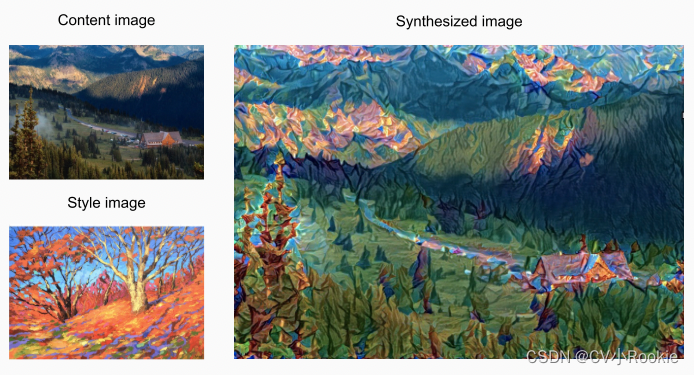当前位置:网站首页>动手学深度学习_风格迁移
动手学深度学习_风格迁移
2022-08-09 16:44:00 【CV小Rookie】
风格迁移(style transfer)是让一张图片内容不发生改变,但样式改为另一张图片效果。

这里所使用的风格迁移并不是基于 GAN 的,而是基于卷积神经网络的风格迁移方法(当然现在主流的风格迁移是基于 GAN 的,感兴趣的可以了解一下 之间写过的一些 GAN 的介绍)

首先,我们初始化合成图像,例如将其初始化为内容图像。 该合成图像是风格迁移过程中唯一需要更新的变量,即风格迁移所需迭代的模型参数。 然后,我们选择一个预训练的卷积神经网络来抽取图像的特征,其中的模型参数在训练中无须更新。 这个深度卷积神经网络凭借多个层逐级抽取图像的特征,我们可以选择其中某些层的输出作为内容特征或风格特征。
接下来,我们通过前向传播(实线箭头方向)计算风格迁移的损失函数,并通过反向传播(虚线箭头方向)迭代模型参数,即不断更新合成图像。
风格迁移常用的损失函数由3部分组成:
(i)内容损失使合成图像与内容图像在内容特征上接近;
(ii)风格损失使合成图像与风格图像在风格特征上接近;
(iii)全变分损失则有助于减少合成图像中的噪点。
最后,当模型训练结束时,我们输出风格迁移的模型参数,即得到最终的合成图像。
搭建网络
使用基于 ImageNet 数据集预训练的 VGG-19 模型来抽取图像特征
pretrained_net = torchvision.models.vgg19(pretrained=True)抽取特征,我们可以选择VGG网络中某些层的输出。 一般来说,越靠近输入层,越容易抽取图像的细节信息;反之,则越容易抽取图像的全局信息。 为了避免合成图像过多保留内容图像的细节,我们选择VGG较靠近输出的层,即内容层,来输出图像的内容特征。 我们还从VGG中选择不同层的输出来匹配局部和全局的风格,这些图层也称为风格层。
style_layers, content_layers = [0, 5, 10, 19, 28], [25]
net = nn.Sequential(*[pretrained_net.features[i] for i in
range(max(content_layers + style_layers) + 1)])
# 保存风格层和内容层的输出
def extract_features(X, content_layers, style_layers):
contents = []
styles = []
for i in range(len(net)):
X = net[i](X)
if i in style_layers:
styles.append(X)
if i in content_layers:
contents.append(X)
return contents, styles
# get_contents函数对内容图像抽取内容特征
def get_contents(image_shape, device):
content_X = preprocess(content_img, image_shape).to(device)
contents_Y, _ = extract_features(content_X, content_layers, style_layers)
return content_X, contents_Y
# get_styles函数对风格图像抽取风格特征
def get_styles(image_shape, device):
style_X = preprocess(style_img, image_shape).to(device)
_, styles_Y = extract_features(style_X, content_layers, style_layers)
return style_X, styles_Y损失函数
由三部分组成:内容损失,风格损失,全变分损失
我们学到的合成图像里面有大量高频噪点,即有特别亮或者特别暗的颗粒像素。 一种常见的去噪方法是全变分去噪(total variation denoising): 假设  表示坐标
表示坐标  处的像素值,降低全变分损失
处的像素值,降低全变分损失

能够尽可能使邻近的像素值相似。
# 内容损失
def content_loss(Y_hat, Y):
# 我们从动态计算梯度的树中分离目标:
# 这是一个规定的值,而不是一个变量。
return torch.square(Y_hat - Y.detach()).mean()
# 风格损失
def gram(X):
num_channels, n = X.shape[1], X.numel() // X.shape[1]
X = X.reshape((num_channels, n))
return torch.matmul(X, X.T) / (num_channels * n)
# 全变分损失
def tv_loss(Y_hat):
return 0.5 * (torch.abs(Y_hat[:, :, 1:, :] - Y_hat[:, :, :-1, :]).mean() +
torch.abs(Y_hat[:, :, :, 1:] - Y_hat[:, :, :, :-1]).mean())
content_weight, style_weight, tv_weight = 1, 1e3, 10
def compute_loss(X, contents_Y_hat, styles_Y_hat, contents_Y, styles_Y_gram):
# 分别计算内容损失、风格损失和全变分损失
contents_l = [content_loss(Y_hat, Y) * content_weight for Y_hat, Y in zip(
contents_Y_hat, contents_Y)]
styles_l = [style_loss(Y_hat, Y) * style_weight for Y_hat, Y in zip(
styles_Y_hat, styles_Y_gram)]
tv_l = tv_loss(X) * tv_weight
# 对所有损失求和
l = sum(10 * styles_l + contents_l + [tv_l])
return contents_l, styles_l, tv_l, l初始化合成图像
与之前训练的网络不同,之前的网络训练的参数是每层网络里面的权重。但是在卷积神经网络的风格迁移中,唯一需要更新的变量是最后需要合成的图像。我们可以定义一个简单的模型SynthesizedImage,并将合成的图像视为模型参数。模型的前向传播只需返回模型参数。
class SynthesizedImage(nn.Module):
def __init__(self, img_shape, **kwargs):
super(SynthesizedImage, self).__init__(**kwargs)
self.weight = nn.Parameter(torch.rand(*img_shape))
def forward(self):
return self.weight定义get_inits函数。该函数创建了合成图像的模型实例,并将其初始化为图像X。风格图像在各个风格层的格拉姆矩阵styles_Y_gram将在训练前预先计算好。
def get_inits(X, device, lr, styles_Y):
gen_img = SynthesizedImage(X.shape).to(device)
gen_img.weight.data.copy_(X.data)
trainer = torch.optim.Adam(gen_img.parameters(), lr=lr)
styles_Y_gram = [gram(Y) for Y in styles_Y]
return gen_img(), styles_Y_gram, trainer训练模型
在训练模型进行风格迁移时,我们不断抽取合成图像的内容特征和风格特征,然后计算损失函数
def train(X, contents_Y, styles_Y, device, lr, num_epochs, lr_decay_epoch):
X, styles_Y_gram, trainer = get_inits(X, device, lr, styles_Y)
scheduler = torch.optim.lr_scheduler.StepLR(trainer, lr_decay_epoch, 0.8)
animator = d2l.Animator(xlabel='epoch', ylabel='loss',
xlim=[10, num_epochs],
legend=['content', 'style', 'TV'],
ncols=2, figsize=(7, 2.5))
for epoch in range(num_epochs):
trainer.zero_grad()
contents_Y_hat, styles_Y_hat = extract_features(
X, content_layers, style_layers)
contents_l, styles_l, tv_l, l = compute_loss(
X, contents_Y_hat, styles_Y_hat, contents_Y, styles_Y_gram)
l.backward()
trainer.step()
scheduler.step()
if (epoch + 1) % 10 == 0:
animator.axes[1].imshow(postprocess(X))
animator.add(epoch + 1, [float(sum(contents_l)),
float(sum(styles_l)), float(tv_l)])
return Xdevice, image_shape = d2l.try_gpu(), (300, 450)
net = net.to(device)
content_X, contents_Y = get_contents(image_shape, device)
_, styles_Y = get_styles(image_shape, device)
output = train(content_X, contents_Y, styles_Y, device, 0.3, 500, 50)
边栏推荐
猜你喜欢

110+ public professional datasets summarized

有什么好的开源自动化测试框架可以推荐?

元宇宙虚拟场景互动获得生活、工作、学习新鲜体验

Can't install the Vmware virtual machine on the Ark Kai server?

冷冻电镜聚类中心(2D Class)粒子图像的解析

学长告诉我,大厂MySQL都是通过SSH连接的

低代码平台和专业开发人员——完美搭档?

crm系统哪家好?好用的crm管理系统推荐
![[ Kitex Source Code Interpretation ] Request to retry](/img/d9/c1871c15cc9124e919d22c9adcc75b.png)
[ Kitex Source Code Interpretation ] Request to retry

kafka 通过 jdbc 从oracle抓取数据
随机推荐
vr虚拟仿真样板间极大节省出样成本-深圳华锐视点
神秘的程序员(20-30)
The difference between approach and method
Redis的那些事:一文入门Redis的基础操作
从事软件测试一年,只会基础的功能测试,怎么进一步学习?
微软 .NET Core 3.1 年底将结束支持,请升级到.NET 6
About the common Hook encapsulation of DOM (2)
FAST-LIO2代码解析(三)
[Code Audit] - PHP project class RCE and files include download and delete
SkiaSharp 之 WPF 自绘 粒子花园(案例版)
智能工具管理系统
dotnet 6 为什么网络请求不跟随系统网络代理变化而动态切换代理
【.NET 6】开发minimal api以及依赖注入的实现和代码演示
[SUCTF 2019]CheckIn
Tan Zhongyi: Do you know who the "Queen of Open Source" is?
冷冻电镜聚类中心(2D Class)粒子图像的解析
有什么好的开源自动化测试框架可以推荐?
.NET Community Toolkit 8.0.0 版本发布
.NET静态代码织入——肉夹馍(Rougamo) 发布1.1.0
自动生成设备节点